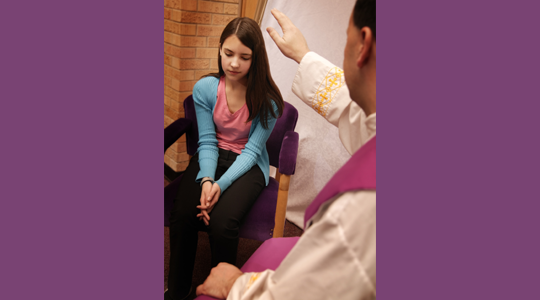Today’s Lenten activity is an opportunity for catechists to help prepare young people to celebrate the Sacrament of Penance and Reconciliation.

Lent, of course, is a season of repentance. For Catholics, the Sacrament of Penance and Reconciliation is an intimate encounter with the Lord’s mercy and forgiving grace. A good confession should always be preceded by an examination of conscience.
An Examination of Conscience
- Fill a glass bowl or a tall drinking glass halfway with water.
- Explain that the clear water represents us when we are in the state of grace – in a healthy relationship with Jesus.
- Pour three small drops of food coloring into the water and stir with a spoon.
- Explain that the food coloring represents sin.
- Comment on how even a small drop affects the whole bowl/glass of water.
- Add approximately two tbsp. of chlorine bleach to the colored water and stir. You will notice the colored water lighten somewhat, but the color will not disappear.
- Sprinkle approximately ½ tsp. of baking soda into the colored water, and stir the ingredients with the spoon. Within seconds, the water will turn completely clear.
- Explain that the Sacrament of Penance and Reconciliation removes our sin and restores us to a state of grace.
- Tell the young people that, before we approach the Sacrament of Penance and Reconciliation, we need to make an examination of conscience – a way of taking a closer look at our relationship with Jesus and with our neighbors to identify what we might be doing (or not doing) to hurt those relationships.
- Do a prayerful examination of conscience with the young people. Invite them to get into a comfortable posture and to close their eyes. Lead them in some deep breathing to quiet them. Consider playing some instrumental music quietly in the background.
- As you lead the examination of conscience, be sure to leave lots of pauses to allow the young people to reflect on each item.
- Here are a number of examinations of conscience for you to choose from (some with general questions, some based on the Commandments, and a few based on the Lord’s Prayer or the Beatitudes):
- An Examination of Conscience
- Guide for Examination of Conscience for Confession of Sins
- Examination of Conscience for Children
- What Are The Beatitudes?
- Examination of Conscience






I will certainly use the example in my CCE class. I have 6th graders. Thanks.
Aurora, I hope it goes well for you and your 6th graders!
These Examination of Conscience examples are great & I can certainly use them, however I have a class of mostly Tweens & can’t access those 2 sites.
Is there any other way to get them. Thanks
This is a fantastic resource and I’m going to use the tween examination of conscience with my 4th grade CCD class tomorrow. Thank you!!!
I plan to use this idea with my Little Flowers Catholic Girls club tomorrow before go to confession together! One question: Is there a separate symbolic meaning behind adding the bleach and the water is only partially clear? I see that after we add the baking soda and it becomes completely clear we can explain to the children the effect of penance and reconciliation but what about that interim moment when the glass is partly colored from the bleach? Just wondering.
Kim, you can use the bleach step to talk about examination of conscience as a prerequisite to the Sacrament of Penance which completes the experience of reconciliation.